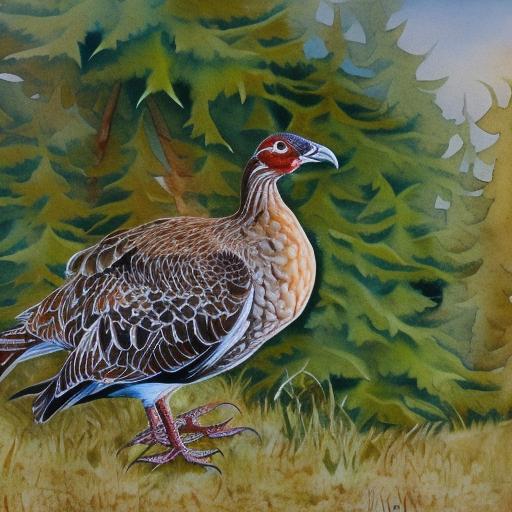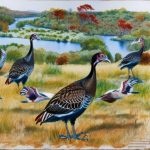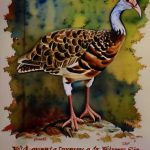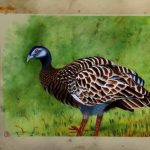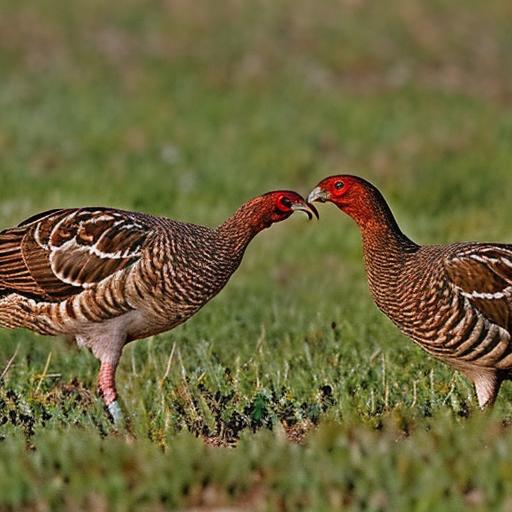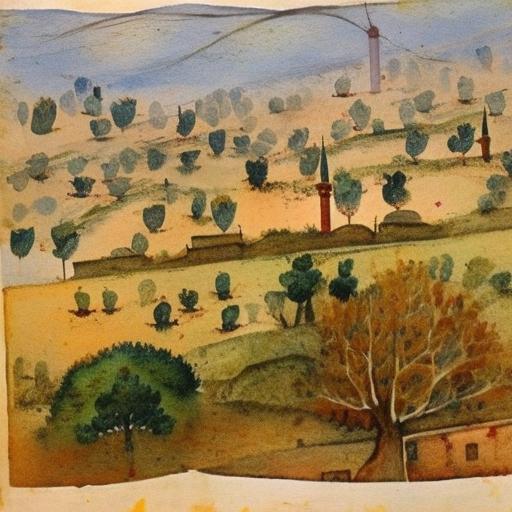Wild turkey breeding is a fascinating and crucial aspect of the life cycle of these iconic birds. The breeding season, also known as the mating season, is a time when male turkeys, known as toms, engage in elaborate courtship displays to attract females, known as hens. This period is essential for the continuation of the wild turkey population and plays a significant role in the overall health and sustainability of the species. Understanding the intricacies of wild turkey breeding is essential for conservation efforts and ensuring the long-term survival of these magnificent birds.
During the breeding season, male turkeys display their vibrant plumage and perform intricate courtship rituals to attract females. The breeding season is a time of heightened activity and excitement in the wild turkey population, as toms compete for the attention of hens and engage in elaborate displays of dominance and virility. The success of wild turkey breeding is crucial for maintaining healthy population numbers and ensuring genetic diversity within the species. As such, it is essential to understand the various factors that influence wild turkey breeding and the impact of the breeding season on the overall population.
Key Takeaways
- Wild turkeys breed in the spring, with the breeding season typically lasting from March to May.
- Factors such as weather, food availability, and habitat quality can influence wild turkey breeding success.
- Signs of the end of wild turkey breeding include decreased gobbling and the dispersal of male turkeys.
- The breeding season can have a significant impact on the population of wild turkeys in a given area.
- Conservation efforts for wild turkey breeding include habitat preservation, predator control, and hunting regulations.
Breeding Season for Wild Turkeys
The breeding season for wild turkeys typically occurs in the spring, although the exact timing can vary depending on geographic location and local environmental conditions. In general, the breeding season begins in late winter or early spring, with toms becoming increasingly vocal and active as they seek out potential mates. During this time, toms will establish territories and engage in elaborate courtship displays to attract hens. These displays often involve puffing up their feathers, fanning their tails, and emitting distinctive gobbling sounds to signal their presence to nearby females.
The breeding season is a time of intense competition among male turkeys, as they vie for the attention of hens and seek to establish dominance within their territories. Toms will engage in aggressive displays, including strutting and sparring with rival males, in an effort to assert their dominance and attract mates. Meanwhile, hens will carefully evaluate potential mates and select the most suitable partner for breeding. Once a pair has formed, they will engage in mating rituals, which may involve elaborate displays of courtship and copulation. The breeding season is a critical period for wild turkeys, as it sets the stage for the next generation of birds and plays a crucial role in maintaining healthy population numbers.
Factors Influencing Wild Turkey Breeding
Several factors can influence wild turkey breeding, including environmental conditions, habitat quality, and population dynamics. One of the most significant factors influencing wild turkey breeding is food availability, as turkeys require a diverse diet to support their reproductive efforts. A lack of suitable food sources can negatively impact the health and reproductive success of wild turkeys, leading to reduced breeding activity and lower population numbers.
Habitat quality also plays a crucial role in wild turkey breeding, as turkeys require suitable nesting sites and cover to protect their eggs and young from predators. Loss of habitat due to deforestation, urban development, and agricultural expansion can significantly impact wild turkey breeding success and population numbers. Additionally, predation pressure can influence wild turkey breeding, as increased predation can reduce nesting success and overall reproductive output.
Population dynamics, including the ratio of males to females within a given area, can also influence wild turkey breeding. In areas with an imbalance of males to females, competition for mates may be heightened, leading to increased aggression and reduced breeding success. Understanding these factors is essential for managing wild turkey populations and implementing effective conservation strategies to support breeding efforts.
Signs of the End of Wild Turkey Breeding
As the breeding season comes to a close, there are several signs that indicate the end of wild turkey breeding activity. One of the most noticeable signs is a decrease in vocalization and courtship displays among male turkeys. As mating activity wanes, toms will become less vocal and aggressive, signaling the conclusion of the breeding season.
Another sign of the end of wild turkey breeding is the dispersal of hens with their newly hatched poults. Once hens have successfully nested and hatched their young, they will lead their broods away from their nesting sites in search of food and suitable habitat. This dispersal marks the transition from the breeding season to the rearing season, as hens focus on caring for their young and teaching them essential survival skills.
Additionally, as the breeding season draws to a close, male turkeys will begin to regrow their feathers, which may have become worn or damaged during the rigors of courtship and mating. This molting process signifies the end of the intense mating activity and marks the beginning of a period of recovery and renewal for male turkeys.
Impact of Breeding Season on Wild Turkey Population
The breeding season has a significant impact on the overall population dynamics of wild turkeys. Successful breeding is essential for maintaining healthy population numbers and ensuring genetic diversity within the species. The number of poults hatched during the breeding season directly influences population growth and sustainability, making it a critical period for wild turkey conservation efforts.
The success of the breeding season can be influenced by various factors, including weather conditions, food availability, predation pressure, and habitat quality. A successful breeding season can lead to an increase in population numbers, while a poor breeding season may result in reduced population growth and overall population decline.
The impact of the breeding season extends beyond immediate population numbers, as it also influences future population dynamics and genetic diversity within the species. Understanding the impact of the breeding season on wild turkey populations is essential for implementing effective conservation strategies and managing sustainable harvests.
Conservation Efforts for Wild Turkey Breeding

Conservation efforts for wild turkey breeding focus on protecting critical habitat, managing predator populations, and promoting sustainable hunting practices. Protecting essential nesting habitat is crucial for supporting successful breeding efforts, as hens require suitable cover and nesting sites to raise their young. Conservation organizations work to preserve and restore critical habitat for wild turkeys, ensuring that suitable nesting sites are available for breeding pairs.
Managing predator populations is another essential aspect of wild turkey conservation efforts. Predation pressure can significantly impact nesting success and overall reproductive output, making it crucial to implement strategies for managing predator populations in areas with high wild turkey densities.
Promoting sustainable hunting practices is also important for supporting wild turkey breeding efforts. By implementing science-based harvest management strategies and regulations, conservation organizations can ensure that hunting activities do not negatively impact wild turkey populations during the critical breeding season.
Overall, conservation efforts for wild turkey breeding focus on protecting essential habitat, managing predator populations, and promoting sustainable hunting practices to support healthy population numbers and genetic diversity within the species.
Conclusion and Future Research on Wild Turkey Breeding
In conclusion, wild turkey breeding is a critical aspect of the life cycle of these iconic birds and plays a significant role in maintaining healthy population numbers and genetic diversity within the species. Understanding the intricacies of wild turkey breeding is essential for implementing effective conservation strategies and ensuring the long-term survival of these magnificent birds.
Future research on wild turkey breeding should focus on understanding the complex interactions between environmental factors, habitat quality, and population dynamics that influence breeding success. By gaining a deeper understanding of these factors, researchers can develop more effective conservation strategies to support wild turkey breeding efforts and promote sustainable population growth.
Additionally, future research should explore the potential impacts of climate change on wild turkey breeding patterns and reproductive success. As environmental conditions continue to shift, understanding how these changes may influence wild turkey populations is essential for developing proactive conservation measures to mitigate potential threats.
Overall, continued research on wild turkey breeding is essential for supporting healthy population numbers and ensuring the long-term sustainability of these iconic birds in their natural habitats. By gaining a deeper understanding of the factors that influence wild turkey breeding and implementing effective conservation strategies, we can work towards securing a bright future for these magnificent birds for generations to come.
If you’re interested in learning more about wild turkeys and their behavior, you might also want to check out this informative article on creating a garden chicken coop. Understanding the natural instincts and habits of wild turkeys can provide valuable insights for creating a suitable environment for domestic poultry as well.
FAQs
What is the breeding season for wild turkeys?
The breeding season for wild turkeys typically occurs in the spring, usually from March to May.
At what age do wild turkeys start breeding?
Wild turkeys usually start breeding when they are around one year old, although some may start as early as 7-8 months old.
When do wild turkeys stop breeding?
Wild turkeys generally stop breeding in late spring or early summer, once the breeding season has ended.
What factors can affect the breeding behavior of wild turkeys?
Factors such as weather, food availability, and habitat conditions can affect the breeding behavior of wild turkeys. Additionally, population density and the presence of predators can also impact their breeding patterns.
How many times do wild turkeys breed in a year?
Wild turkeys typically only breed once a year during the spring breeding season. However, some may attempt to breed again if their first nesting attempt fails.
Meet Walter, the feathered-friend fanatic of Florida! Nestled in the sunshine state, Walter struts through life with his feathered companions, clucking his way to happiness. With a coop that’s fancier than a five-star hotel, he’s the Don Juan of the chicken world. When he’s not teaching his hens to do the cha-cha, you’ll find him in a heated debate with his prized rooster, Sir Clucks-a-Lot. Walter’s poultry passion is no yolk; he’s the sunny-side-up guy you never knew you needed in your flock of friends!

